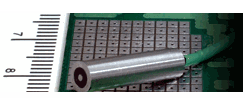

Tel: +44(0)7976772841 tom@sensatech.com
 |
Custom Electronic Sensing Solutions |  |
67 Wolseley
Road, Brighton, BN41 1SS Tel: +44(0)7976772841 tom@sensatech.com |
|
| Company Registration No. 10313103 | ||||
Array Control Software Development Amplifier Design Electrical Impedance Tomography Remote Sensing Electric Field Sensing Look through/around Targets Technology |
Technology The principle of capacitive sensing is not a new one. The technique relies on the fact that any object in free space has an electrical capacitance to earth. The value of this capacitance depends on several factors, the principle ones being the object's surface area, the distance to earth and the permittivity of the intervening medium. The range and sensitivity of an instrument depends on the ability of the electronics to accurately measure extremely small values of capacitance. It is in this area that much of Sensatech's research has been focused, resulting in techniques which maximise noise rejection and minimise the unwanted effects of temperature. Sensatech has developed specific and unique skills focused around areas critical to the development and production of complex sensing solutions. Array control Arrays of multiple sensor heads are multiplexed to
allow Sensatech to collect large sets of data and build
images of a target object which can then be analysed with
proprietary embedded software. Because through careful
electrode design, parasitic capacitance remains very
small, Sensatech are able to measure down to 3 femto
farad total capacitance with 12 bit resolution and 3 atto
farad accuracy. Such small change is valuable for example
in gap measurement. Software development Data sets generated by sensor arrays can be large and
complex. Some arrays contain 2000 odd electrodes all of
which are scanned and the resulting data once processed
provides knowledge of the target object. Amplifier design Low noise with high input impedance and low
capacitance guard amplifiers have been built with
excellent temperature stability. EIT Electrical impedance tomography Uses array generated data, then using back propagation techniques compares and reshapes the permeability characteristics of the space until it meets the data found by the sensor. This is the basis of X-RAY type tomography that Sensatech carry out using electric fields. While EIT is normally carried out with a transmitter and receiver plate in contact with the target object, using the techniques outlined above, Sensatech do not require to contact or invade the target object and can non invasively detect through other materials. Remote sensing Sensor Head can be 15m away from the amplifier and
signal electronics. Basic types of electric field sensing
Look through/around Targets Technology Because Sensatech uses field sensing techniques as opposed to beam sensing techniques, our sensor can work effectively where others fail. |
Home - Company - Technology - Applications - Solutions - Press - Career - Contact Copyright © 2003-2013 Sensatech Designs Ltd, 12 Stanley Street, Brighton, BN2 0GP UK |